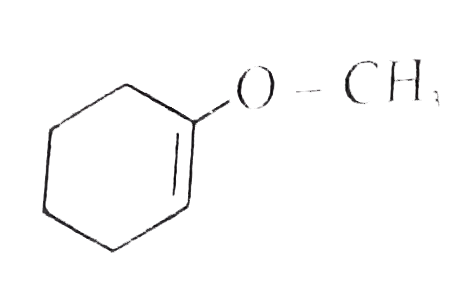Alkenes mainly undergo
electrophilic addition reactions
nucleophile addition reactions
free-radical addition reactions
both and (1) and (3)
The correct Answer is:A
Because the π bond results from overlapping p orbitals, the π electrons lie above and below the plane of the double bond. Therefore, the electrons of the π bonds are exposed and susceptible to electron-seeking reagents called electrophiles. Electrophiles include positive reagents such as protons (H+), neutral reagents such as bromine ( beacuse it can be polarized so that one end is positive), and the Lewis acids such as AlCl3 and BF3. Metal ions containing vacent orbitals such as silver as silver ion (Ag+), mercuric ion (Hg2+), and platinum ion (Pt2) also act as electrophiles.
Topper's Solved these Questions
- BOOK - R SHARMACHAPTER - ALKENESEXERCISE - Follow-up-84videos
ALKENES
- BOOK - R SHARMACHAPTER - ALKENESEXERCISE - Follow-up-99videos
ALKENES
- BOOK - R SHARMACHAPTER - ALKENESEXERCISE - Follow-up-64videos
ALKENES
- BOOK - R SHARMACHAPTER - ALKANESEXERCISE - ARCHIVES17videos
ALKANES
- BOOK - R SHARMACHAPTER - ALKYNESEXERCISE - Archives42videos
ALKYNES
Similar Questions
Knowledge Check
- Question 1 - Select One
Alkenes undergo a variety of oxidation reactions. With cold and neutral or alkaline KMnO4, alkenes are oxidised to give vicinal diols. Oxidation with hot KMnO4 undergoes cleavage of C=C bond leading to the formation of carboxylic acids, ketones and carbon dioxide depending on the nature ofalkene. Reductive ozonolysis of alkenes give aldehydes or ketones.
Reductive ozonolysis of alkene 'A' gives propanone. The alkene 'A' isA2,3,-Dimethylbut-2-eneB1,4-Dimethylpent-2-eneC1,3-Dimethylbut-2-eneD2-Methylpropene - Question 2 - Select One
Alkenes undergo a variety of oxidation reactions. With cold and neutral or alkaline KMnO4, alkenes are oxidised to give vicinal diols. Oxidation with hot KMnO4 undergoes cleavage of C=C bond leading to the formation of carboxylic acids, ketones and carbon dioxide depending on the nature ofalkene. Reductive ozonolysis of alkenes give aldehydes or ketones.
An alkene 'X' on treatment with hot alkaline KMnO4 gives acetic acid. Alkene X' isAHex-3-encBBut-2-eneCBut-1-eneDPent-1-ene - Question 3 - Select One
Alkenes undergo electrophilic addition reactions. Electrophilic addition to unsymmetrical alkenes involve the formation of a more stable carbocation intermediate in the first step which is rate determining and carbocation is then attacked by a nuclephile to form product
Which one of the following alkene reacts most readily with HCI?ACH2=CH−ClBCH2=CH−O−CH3CCH3−CH=CH−CH3D
Alkenes and alkynes are unsaturated hydrocarbons and undergo electrophilic addition reactions. In alkenes, the addition occurs in one step while in alkynes the addition occurs in two steps. Alkenes show geometrical isomerism but alkynes do not. Alkynes are more acidic than alkenes which are more acidic than alkanes. Both alkenes and alkynes can be prepared by the electrolysis of sodium or potassium salts of carboxylic acids.
Write the major product of the reaction :
(CH3)3C−CH=CH2HBr−−→View SolutionAlkenes and alkynes are unsaturated hydrocarbons and undergo electrophilic addition reactions. In alkenes, the addition occurs in one step while in alkynes the addition occurs in two steps. Alkenes show geometrical isomerism but alkynes do not. Alkynes are more acidic than alkenes which are more acidic than alkanes. Both alkenes and alkynes can be prepared by the electrolysis of sodium or potassium salts of carboxylic acids.
Which of the following reacts with [Cu(NH3)2]OH ?
(i) But-1-yne (ii) But-2-yne (iii) But-1-eneView SolutionAlkenes undergo a variety of oxidation reactions. With cold and neutral or alkaline KMnO4, alkenes are oxidised to give vicinal diols. Oxidation with hot KMnO4 undergoes cleavage of C=C bond leading to the formation of carboxylic acids, ketones and carbon dioxide depending on the nature ofalkene. Reductive ozonolysis of alkenes give aldehydes or ketones.
But-2-ene on treatment with cold alk. KMnO4 givesView SolutionAlkenes undergo a variety of oxidation reactions. With cold and neutral or alkaline KMnO4, alkenes are oxidised to give vicinal diols. Oxidation with hot KMnO4 undergoes cleavage of C=C bond leading to the formation of carboxylic acids, ketones and carbon dioxide depending on the nature ofalkene. Reductive ozonolysis of alkenes give aldehydes or ketones.
2-Methyl propene on treatment with hot alkaline KMnO4 givesView SolutionAlkenes undergo electrophilic addition reactions. Electrophilic addition to unsymmetrical alkenes involve the formation of a more stable carbocation intermediate in the first step which is rate determining and carbocation is then attacked by a nuclephile to form product
 +H2OH2SO4−−−→ ProductView Solution
+H2OH2SO4−−−→ ProductView Solution

